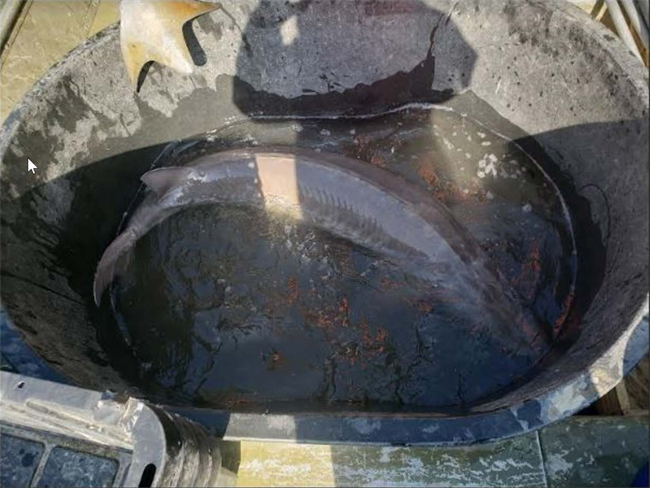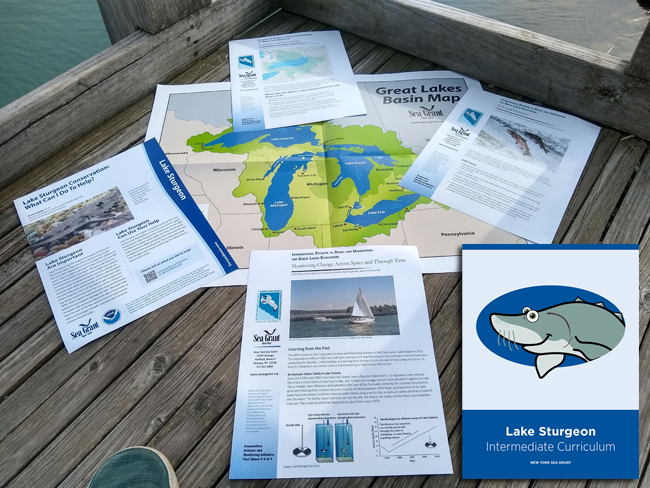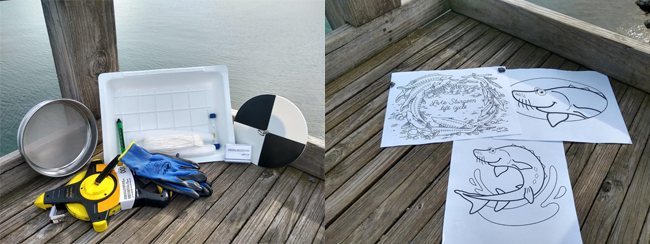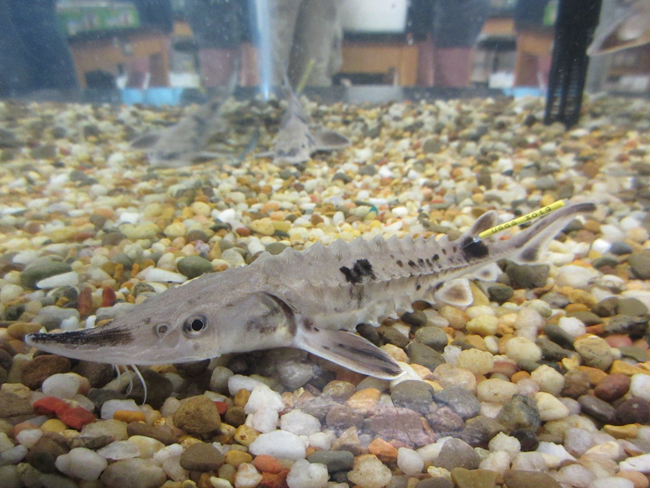— Filed by Kara Lynn Dunn for Thousand Islands Life, Volume 16, Issue 9, September 2021
Buffalo, NY, September 14, 2021 - There’s good news in the effort to restore the lake sturgeon to the fresh waters of the Great Lakes-St. Lawrence River system. This fish is often called a “living fossil fish”, because of its prehistoric appearance and longevity.
The June 2019 issue of Thousand Islands Life highlighted efforts to restore the lake sturgeon (Acipenser fulvescens) to New York’s fresh waters, from the St. Lawrence River and Lake Ontario, to the Niagara River, Lake Erie, inland waters, and canals. The once abundant populations of this fish declined until the lake sturgeon was designated a New York State Threatened Species in 1983.
The Ontario Ministry of Natural Resources designates the lake sturgeon’s status as a Species at Risk, Species of Special Concern, Threatened, or Endangered, depending upon the specific body of water. It is listed as Threatened in the Upper St. Lawrence River and in Northwestern Ontario.
Recent milestones for lake sturgeon conservation in New York waters have generated new excitement and support for sturgeon research, stocking efforts, and educational outreach by New York State, federal (U.S. and Canadian), provincial, Tribal, academic, and nonprofit entities.
In May 2021, U.S. Geological Survey (USGS) Research Ecologist Dawn Dittman, Ph.D., captured and released a 61-inch, almost 70-pound, female lake sturgeon in the Genesee River, 18 years after it was stocked in the river as a juvenile fish. This was the first confirmation of a reproductively-active sturgeon that had been previously stocked in the Genesee River by the lake sturgeon restoration research team.
Three days after the Genesee River discovery, Cornell University fisheries researchers captured and released a lake sturgeon identified as the largest fish ever recorded in Oneida Lake. The 73.6-inch fish weighed 159.4 pounds and is believed to be 26 years old, one of the sturgeon stocked into the lake in 1995.

This mature female lake sturgeon was held in a holding tub temporarily after discovery by USGS researchers on the Genesee River in May 2021. Credit: USGS
“The lake sturgeon is a species of concern across all of the Great Lakes Basin. It is the largest and longest-lived native fish throughout the basin, and it is an indicator of the overall health of the ecosystem. It is very exciting to be able to document this 18-year-old female with mature eggs near the spawning habitat in the Genesee River,” Dittman said.
The USGS, with partners, also tracks spawning activity by the natural populations of lake sturgeon in the greater Thousand Islands region of New York State, the USGS has documented activity in the St. Lawrence River, on the Iroquois Dam improved spawning beds, in the Black River, and at the mouth of the Oswegatchie River.

New York Sea Grant developed a suite of lake sturgeon conservation and education resources, including a Lake Sturgeon Intermediate Curriculum. Credit: NYSG/Nate Drag
New Lake Sturgeon Educational Resources
With a grant from the Disney Conservation Fund, New York Sea Grant developed a suite of lake sturgeon conservation and education resources, including a Lake Sturgeon Intermediate Curriculum and video freely accessible online at www.nyseagrant.org/lakesturgeon.
New York Sea Grant’s Great Lakes Fisheries and Ecosystem Health Specialist Stacy Furgal notes, “New York Sea Grant’s suite of lake sturgeon resources serve as a springboard into the world of science, environmental stewardship, and STEM (science, technology, engineering and mathematics) careers, by featuring this charismatic and threatened species that is so important to the Great Lakes-St. Lawrence River region.”
New York Sea Grant’s Great Lakes Coastal Literacy Specialist Nate Drag notes, “To broaden the reach of the curriculum to all grade levels, input from teachers participating in two curriculum development workshops is incorporated throughout the 10 lesson plans, to encourage skill development in reading and comprehension, mathematics, ecology, graphing, history, and the arts.”
A “Sturgeon Sack” of curriculum collateral teaching materials, which includes digital worksheets, field sampling equipment, a fish tracking tag, and the “Tale of a Great White Fish” book, about a fish facing survival challenges similar to those threatening the lake sturgeon, is available on loan. Interested teachers can contact Drag, who also serves as Associate Director of the Great Lakes Program at the University at Buffalo, at the New York Sea Grant office in Buffalo: 716-645-3610, nwd4@cornell.edu.

Left: Field sampling gear is a collateral teaching resource with the New York Sea Grant Lake Sturgeon Intermediate Curriculum; Right: lake sturgeon coloring pages. Credit: NYSG/Nate Drag
Special Note: The fishing of lake sturgeon is still prohibited in New York. If an angler should catch a lake sturgeon, it must be returned to the water. For more information on the New York State Lake Sturgeon Recovery Plan, please see the NYSDEC website. For fishing regulations for the Canadian provinces, see "Recreational Fishing Regulations".

Juvenile lake sturgeon. Credit: New York Sea Grant
More Info: New York Sea Grant
New York Sea Grant (NYSG), a cooperative program of Cornell University
and the State University of New York (SUNY), is one of 34 university-based
programs under the National Oceanic and Atmospheric Administration’s
National Sea Grant College Program.
Since 1971, NYSG has represented a statewide network of integrated
research, education and extension services promoting coastal community
economic vitality, environmental sustainability and citizen awareness
and understanding about the State’s marine and Great Lakes resources.
Through NYSG’s efforts, the combined talents of university scientists
and extension specialists help develop and transfer science-based
information to many coastal user groups—businesses and industries,
federal, state and local government decision-makers and agency managers,
educators, the media and the interested public.
The program maintains Great Lakes offices at Cornell University, SUNY
Buffalo, SUNY Oswego and the Wayne County Cooperative Extension office
in Newark. In the State's marine waters, NYSG has offices at Stony Brook
University in Long Island, Brooklyn College and Cornell Cooperative
Extension in NYC and Kingston in the Hudson Valley.
For updates on Sea Grant activities: www.nyseagrant.org has RSS, Facebook, Twitter, Instagram, and YouTube links. NYSG offers a free e-list sign up via www.nyseagrant.org/nycoastlines for its flagship publication, NY Coastlines/Currents, which is published quarterly.